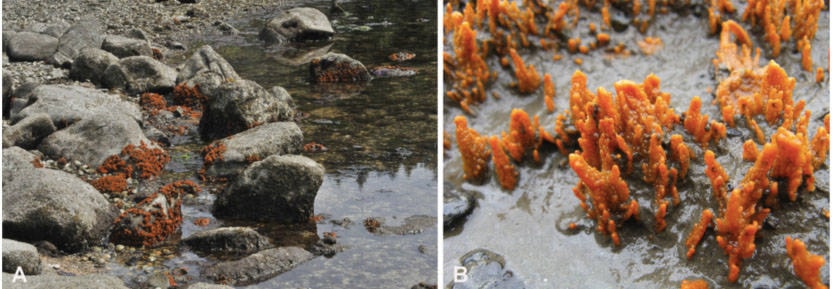A retired government marine biologist is trying to identify what may be an entirely new species, but is more likely the latest example of an ongoing marine invasion into Ladysmith Harbour.
Rick Harbo, who worked for 36 years for the Department of Fisheries and Oceans and is now a research associate with the Royal Museum in Victoria, has discovered a unique sea sponge that may only be found at the head of Ladysmith’s harbour.
“We found a new species of sponge. I believe it was introduced. It’s probably not a new species, but we’ve looked through the literature and have not been able to find a description of it,” Harbo said.
Further information about the sponge — named Lysodendrix literalis is limitied. But Harbo said it isn’t the only ‘unusual’ creature living in Ladysmith’s harbour.
“It’s one of the most invaded harbours that we have on our coast here,” he said. “You’d be hard-pressed to go anywhere in Ladysmith and not find an introduced species.”
Harbo also found a large presence of the non-native European sponge Hymeniacidon perlevis — the first recorded presence of the sponge in Canadian waters. Harbo’s findings were published in the scientific journal BioInvasions Records (2021) Volume 10, Issue 2.
The bright orange hymeniacidon sponge has prospered in the warm waters of the tidal flats by Bush Creek in the northern end of Ladysmith Harbour.
“It’s highly visible. It was growing all over the rocks. I had never seen anything like it before. That’s what got me interested in trying to identify it,” Harbo said.
Hymeniacidon only grows at the head of the harbour where the water is warmest. Harbo said the sponge is a good species to watch to monitor the impacts of climate change.
“If water temperatures increase their distribution will increase,” he said.
Harbo suspects hymeniacidon found its way to Ladysmith through the shipping industry, either on the hull of a ship or through historical aquacultural activities. In the 1900s, oysters from Atlantic Canada and from Japan were grown and harvested in Ladysmith.
That activity led to a host of invasive species settling in the harbour including Japanese seaweed, Japanese skeleton shrimp, Japanese oyster drill, pacific oysters, manilla clams, and several species of non-native mussels to name a few. Harbo has compiled a list of 45 non-native species in Ladysmith’s harbour, though he suspects there are more.
The main reason why these species have prospered in Ladysmith is because of how warm the waters are. None of the invasive or non-native species are threatening the native ecosystem at this time.
“It’s still a thriving harbour. It’s quite interesting in terms of all the activities that have gone on in Ladysmith and continue to go on from marinas, log sorting, to log dumping,” Harbo said.
“In spite of that, the harbour seems to be pretty resilient.”
For more news from Vancouver Island and beyond delivered daily into your inbox, please click here.
RELATED: Glass sponge reef recommended as World Heritage Site
RELATED: ‘One of worst’ invasive crustaceans found on Lower Mainland shoreline
